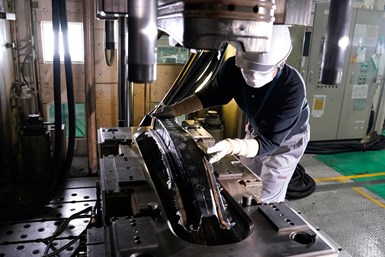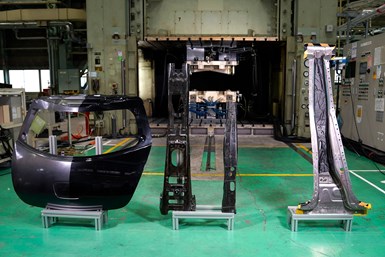Nissan Speeds CFRP Process
Advanced simulation and improved compression molding could be the key to carbon fiber’s future
Carbon fiber is at the extreme end of the materials spectrum, offering high rewards at a steep price. The material can cut a part’s mass in half compared with a traditional steel unit. On the downside (and this is a biggie), it can be 10 times as expensive.
That’s not a winning tradeoff for mass-produced vehicles. But a new Nissan process aims to make a better business case for the pricey lightweight material.
Speedy Simulations and Mold Times
The carmaker is developing a faster way to design and produce parts made from carbon-fiber-reinforced plastics (CFRP). This in turn could help lower costs to make mainstream applications viable.

Nissan is speeding up CFRP production capabilities. (Images: Nissan)
By using more advanced computer modeling techniques and in-die temperature sensors, Nissan says it’s able to cut development times in half for CFRP parts.
The simulation takes into account more than 20 variables, including the material properties of the carbon fiber and resin. This allows engineers to calculate how the resin will settle during an improved compression-resin-transfer-molding (CRTM) process. Grooves then are cut into the molds to better direct resin flow and optimize a part’s overall material performance properties, according to the carmaker.
Nissan places preformed carbon fiber into the CRTM mold, then injects resin into the die prior to pressing. This reduces cycle times to just two minutes, compared with 10 minutes for conventional methods.
Why it Matters
Faster development and production times will streamline the process and reduce costs.

Nissan aims to use CFRP in structural components within 5 years.
This in turn could enable carmakers to use CFRP to help reduce weight in mainstream vehicles. The material currently is limited to race cars, ultra-luxury models and niche applications.
Nissan plans to begin using CFRP parts made from the process in SUV/crossover vehicles within five years. It lists B-pillars and other structural components among the potential applications.
RELATED CONTENT
-
On Developments at Lincoln, Magna, Fiskar, Volvo and More
Lincoln’s plans for electric; Magna and Fisker working together; Polestar in South Carolina; the Volvo XC60 driven; VW gets deep into 3D; Porsche exec on electric; BMW and hydrogen; Staubli cell for tire sensors; and Bridgestone invests in autonomous trucking company.
-
Things to Know About Cam Grinding
By James Gaffney, Product Engineer, Precision Grinding and Patrick D. Redington, Manager, Precision Grinding Business Unit, Norton Company (Worcester, MA)
-
on lots of electric trucks. . .Grand Highlander. . .atomically analyzing additive. . .geometric designs. . .Dodge Hornet. . .
EVs slowdown. . .Ram’s latest in electricity. . .the Grand Highlander is. . .additive at the atomic level. . .advanced—and retro—designs. . .the Dodge Hornet. . .Rimac in reverse. . .








